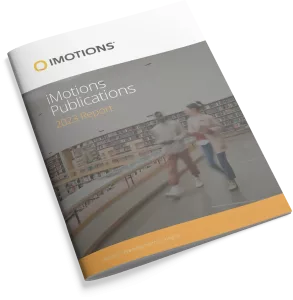-
Get Your Project Funded: Using Biometric Data to Understand What Makes People Trust and Support Crowdfunding Campaigns
Abstract: Creating a good crowdfunding campaign is difficult. By understanding why people contribute to crowdfunding campaigns we can make campaigns better and raise more money. Crowdfunding websites allow entrepreneurs to make a pitch, which is watched by potential funders. This article describes a pilot of an experiment that measures how people react to both successful […] -
Multimodal Language Analysis in the Wild: CMU-MOSEI Dataset and Interpretable Dynamic Fusion Graph
Abstract: Analyzing human multimodal language is an emerging area of research in NLP. Intrinsically human communication is multimodal (heterogeneous), temporal and asynchronous; it consists of the language (words), visual (expressions), and acoustic (paralinguistic) modalities all in the form of asynchronous coordinated sequences. From a resource perspective, there is a genuine need for large scale datasets that […] -
Automated Pain Detection in Facial Videos of Children using Human-Assisted Transfer Learning
Abstract: Accurately determining pain levels in children is difficult, even for trained professionals and parents. Facial activity provides sensitive and specific information about pain, and computer vision algorithms have been developed to automatically detect Facial Action Units (AUs) defined by the Facial Action Coding System (FACS). Our prior work utilized information from computer vision, i.e. […] -
User Centred Design of Social Signals Feedback for Communication Skills Training
Abstract: Affective technologies enable the automatic recognition of human emotional expressions and nonverbal signals which play an important part in effective communication. This paper describes the use of user-centred design techniques to establish display designs suitable for feeding back recognised emotional and social signals to trainees during communication skills training. The channels of communication investigated […] -
Integrating metacognitive judgments and eye movements using sequential pattern mining to understand processes underlying multimedia learning
Abstract: Metacomprehension is key to successful learning of complex topics when using multimedia materials. The goal of this study was to determine if eye-movement dyads could be: (1) identified by sequence mining techniques, and (2) aligned with self-reported metacognitive judgments during learning with multimedia materials that contain conceptual discrepancies designed to interfere with participants’ metacomprehension. Thirty-two […] -
Impact of Learner-Centered Affective Dynamics on Metacognitive Judgements and Performance in Advanced Learning Technologies
Affect and metacognition play a central role in learning. We examine the relationships between students’ affective state dynamics, metacognitive judgments, and performance during learning with MetaTutorIVH, an advanced learning technology for human biology education. Student emotions were tracked using facial expression recognition embedded within MetaTutorIVH and transitions between emotions theorized to be important to learning […] -
The Effects of Designers Contextual Experience on the Ideation Process and Design Outcomes
Abstract: Personal context-specific experience can affect how a designer evaluates a design problem and proposes solutions. However, this effect was seldom discovered in a quantitative manner in problem-solving design tasks. This paper uses empirical evidence and quantitative methods to show the effects of novice designers’ contextual experience on design tasks, particularly as it relates to […] -
Galvanic Skin Response as a Simple Physiology Lab Teaching Tool- An Alternative Indicator of Sympathetic Arousal
Background: Sympathetic arousal response due to rewarding emotion may not be considered threat to the well-being but such arousal response evoked by fear or punishment can be stressful. When such changes are recorded in lab as biological signals, induced with appropriate stimulus, the observed response may serve as a good indicator of homeostatic alteration. In […] -
Comparative Study of Laptops and Touch-Screen PCs for Searching on the Web
Abstract: This study compares the use of a laptop versus a touch-screen PC to perform web-based information search tasks. Thirty-six participants took part in a lab-based experiment. They were asked to use either a laptop or a touch-screen PC to seek information on the web and retrieve relevant pieces of information while their sessions were […] -
A Test of the Rapid Formation of Design Cues for Product Body Shapes and Features
Abstract: Consumers often use a product’s visual design as a mental shortcut to judge its unobservable attributes. Mental associations between visual design and unobservable attributes aid consumers in their judgments, and hypothetically reduce consumers’ mental load. This paper describes a study that shows the possibility of quickly creating an association in subjects’ minds between a […]
Research Report 2024
In-depth look at the scientific landscape as powered by iMotions software, showcasing groundbreaking research and the impact of our tools in various scientific and industrial fields.

iMotions Science Resources
Looking for white papers, validation reports or research show casing iMotions Multimodal capabilities?
Share Your Research

850+ universities worldwide with an iMotions human behavior lab
73 of the top 100 highest ranked universities
710+ published research papers using iMotions
iMotions is used for some of the most interesting human behavior research studies carried out by top researchers around the world. Contact us to have your publication featured here.
The authors of these publications have used iMotions as a software tool within their research.
“Software should be cited on the same basis as any other research product such as a paper or a book; that is, authors should cite the appropriate set of software products just as they cite the appropriate set of papers” (Katz et al., 2020).
We therefore encourage you to cite the use of iMotions where appropriate.
How to cite iMotions
APA
iMotions (10), iMotions A/S, Copenhagen, Denmark, (2024).
Note: adjust the version and year where relevant.
5 Most Popular Blogs
Publications
Read publications made possible with iMotions
Blog
Get inspired and learn more from our expert content writers
Newsletter
A monthly close up of latest product and research news


